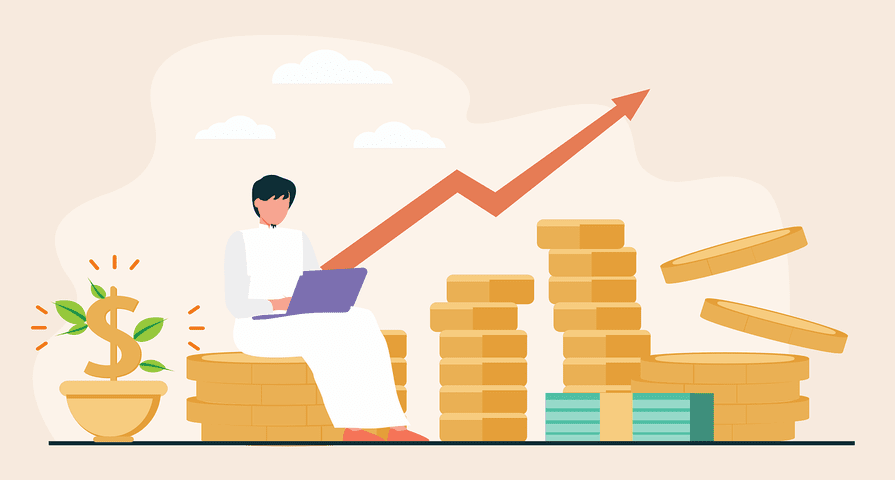Do you know an easy way to earn quick and huge amounts of money? Guess what? It is the stock market. At least, this is what teenagers believe nowadays when they enter the stock market with the hope of making quick, massive profits and aim to become billionaires after seeing manipulated profits and exaggerated success stories on social media. However, the reality often turns out differently.
According to a report by SEBI dated September 23, 2024, a study reveals 93% of individual traders incurred losses in Equity and F&O between FY22 and FY24, where the aggregate losses exceeded Rs 1.8 Lakh Crores over three years and, in FY24 alone the losses amounted to ₹750 billion.
So, imagine the craze of trading among the individuals and how much better off these individuals would have been, if instead of trading, they had invested their money in the market during the same years. If we look at the data from FY22 to FY24, the Nifty 50 Index delivered a return of nearly 51% at its peak on September 27, 2023, and about 36% till November 22, 2024. Had the lost trading amount been invested in the stock market, it would have grown to 2.7 Lakh Crores at its high and ₹2.44 lakh crore at current levels.
Remember, the Nifty 50 index moves slower than the stocks and is considered to be the safest option than stocks, which is available to all of us with the lowest risk. If we analyze the data in the long term, its Compound Annual Growth Rate (CAGR) has been 15.1% over the last 20 years (since 2002) and 11.86% over the past decade (since 2012). Don’t you think you can grow your money more effectively by choosing a safer option of investing in an Index (Exchange-Traded Funds) that offers better returns than the interest rate on fixed deposits or stocks, if you really know how to pick the sound and good quality undervalued stocks?
This blog focuses on why investment is essential today and where you should consider investing your money if you are losing in trading. So, let’s explore the world of investing.
Table of Contents
Introduction

Every one of us enters the market to earn quick money with very little amount in hand. While investing requires good money along with patience to build wealth – the qualities that many young people may lack, the shortest route that appears to each of the participants entering the market is trading, which gives enough leverage and margin.
Trading is not for Everyone
Success in trading isn’t an easy task and not at all for everyone as it requires high skill, discipline, and emotional control. Only those who manage to eliminate the emotional factor from their decisions and can cut losses quickly during trading have a chance of surviving in this space. For being successful traders, it’s crucial to focus on risk and money management, alongside a deep, consistent practice of trade analysis. But even with all these efforts, the chances of success in trading are much lower compared to investing.
Individuals need to realize that even after dedicating time to learning and practicing trading with technical analysis, if it’s not yielding the desired results, it may be time to change direction as we all know that not everything works for everyone. If after putting in at least a year of honest effort, trading is still not working for you, it’s better to pivot toward investing rather than eroding your capital, as investing is the proven way to build significant wealth over time. Many investors start with trading before transitioning to long-term investing, so why not begin investing earlier if trading isn’t helping you succeed?
Stock Market: A Deep Well that can Quench your Thirst
I vividly recall a line from one of the Indian web series named Scam 1992: “Stock market itna gehra kuaan hai jo pure desh ki pyaas bujha sakta hai” which means the stock market is such a deep well, that it can quench the thirst of the entire country and this statement perfectly captures the profound impact of the stock market.
So, indeed stock market is a place that can help you build your wealth but it’s important to remember that it’s not just about earning money through trading, and if trading is not becoming your friend, the next option to consider is investing which can although take longer to generate returns but also carries less significant risk compared to trading.
Follow the Approach – Invest in Stocks by using the Route of Technical Analysis

Investment not only allows you to navigate the stock market and helps you learn about it but also helps you lead a stress-free life compared to the emotional roller-coaster of trading that you experience with trading futures and options in your trading account.
So, why not adopt a strategy that combines technical analysis with fundamental research when investing, that could yield far better results than focusing solely on high-risk instruments, where more than 93% of traders end up losing money and only 1% make the most out of it?
Also Read: Stock Analysis: Things to Follow & Avoid in the Stock Market
What is an Investment?
While we understand that investing can have many benefits, it is important to understand what investment means? Investment is the allocation of money into an asset, project, or venture with the expectation to generate income or gain profit over time. The prime purpose of investment is to grow wealth or income. In essence, investments are nothing but a means to increase our wealth and assets by taking on some level of risk in the hopes of receiving a positive financial outcome and we need it so that we can solve our economic or financial problems properly.
In general, investments are characterized by a trade-off between risk and return, where higher potential returns are usually associated with higher risks. Investments can be held for the short term or the long term, depending on an investor’s goals and financial strategies.
Why is there a need for Investment Today?

With bank fixed deposit (FD) interest rates at a record low of 5% per annum, it is unable to keep up with inflation rising at the rate of 6% annually, and to make matters worse, even this interest is taxable, with the banks or financial institutions deducting tax at source at the end of each year during the time of payment of interest. The tax deduction rate is 10% if the income from interest exceeds Rs 40,000, which means you can’t earn more than Rs 40000 without paying taxes.
For this reason, it is important for individuals to engage in financial planning as without proper planning, one may face significant financial challenges in the future, and to handle these potential crises, substantial financial resources will be required and there comes the role of stock market which is so far considered the best place to invest and grow your money.
Thanks to numerous online broking platforms, through which you can invest in digital assets in the stock market potentially earning an annual return of close to 40% as investors like Warren Buffett have earned and proved (41% CAGR) previously. This not only helps you beat inflation but also provides much higher returns, allowing you to enjoy a more comfortable lifestyle.
Additionally, by investing in the stock market you are not only building your wealth but also contributing to the Indian economy by investing in Indian companies which mirror India’s growth and play a key role in providing a path to become a global superpower.
Believe it or not, our parents are some of the world’s biggest investors. They invest in their children for 20 to 25 long years, spending on education, lifestyle, and more, all to help them settle down in life, whether through a job or a business. Once their children start earning, parents see this as their “dividend”—the return on their long-term contribution.
So, when our parents are already investors, why not adopt this habit and start investing in the stock market, rather than chasing quick-money schemes?
Objectives of Investment

As you move ahead in life, your need for money will increase because of rising inflation and increasing responsibilities in life as that will demand an increase in your expenses and that is where investment comes into play. Many of the primary objectives of investment are listed below:
1. Protect the Value of Money from Inflation
Investing helps safeguard your money from unnecessary spending and protects it from the eroding effects of inflation. Inflation gradually diminishes the value of your money until you invest that money in an investment option. By investing, you get a chance to manage inflation and minimize the gap between the return on your money and the rate of inflation.
2. Increases Savings
Investing is the only way to grow your principal amount, as it allows you to earn interest on your money, and to significantly increase your investment, you can reinvest the interest or returns you earn, which will generate even higher returns over time.
3. Add a Fund for Emergencies
Life is often filled with ups and downs, and today, many people are experiencing even more of these fluctuations. If you’re currently earning a good income, consider setting aside a significant portion into a separate fund for future emergencies. This will provide you with a solid financial backup in times of need.
4. Securing your Retirement Life
If you are young, then you should plan to create a separate investment fund for your retirement without wasting time. Retirement is a phase when you may have limited income sources, and physical work may become difficult. Creating a retirement fund is the key to achieving financial freedom in your later years, making it another valuable benefit of investing.
5. An Alternate to Save Tax on your Income
Nowadays, there are many types of tax saving schemes available in the market. By investing here, you can easily get tax benefits by deducting it from your taxable income. Out of these, Life Insurance Corporation (LIC), PPF, Sukanya Yojana, and NPS are the major tax saving schemes.
Where to Invest?

There exist various investment options/asset classes, such as:
- Stocks: It involves purchasing the shares of a company, thereby having fractional ownership, and standing a chance to gain from the dividends and price of the stock.
- Bonds: It involves lending money to a government or corporation for a specified period in exchange for periodic interest payments and return of principal at maturity.
- Real Estate: It involves buying a property to either generate rental income or gain from the appreciation in price.
- Mutual Funds and ETFs: Mutual funds and ETFs are referred to as pooled investments where money from multiple investors is used to buy a diversified portfolio of stocks, bonds, or other assets. While mutual funds also invest in stocks, instead of individual investors directly purchasing shares, they provide their money to a fund manager, who then allocates the funds across a variety of stocks, creating the mutual fund.
- Commodities: It refers to investments in physical assets such as gold, oil, or agricultural products for hedging purposes against inflation or market volatility.
- Business Ventures: It involves investing in start-ups or existing businesses with the hope of returns via earnings or capital appreciation.
- Cryptocurrencies: An era of digitalization saw investments in digital currencies known as cryptocurrencies like Bitcoin, Ethereum, etc.
People face a lot of problems in investing because they do not know which investment option will help them achieve their goals on time and avoid any financial crisis in the future. The table below provides an overview of various asset classes that can assist you in building your wealth:
| Asset Classes | Liquidity | Risk-Return | Ideal Holding Period |
|---|---|---|---|
| Savings Account | Similar to Cash | Very Low | 0 |
| Fixed Deposit | Low Liquidity | More than Savings Account | 7 Days – 10 Years |
| Gold | High Liquidity | Medium | 5-7 Years |
| Stocks | High Liquidity | Very High | 3-30 Years |
| Mutual Funds | Medium to High Liquidity | High | 5-10 Years |
| ULIP | Low Liquidity | Medium to High | 5-81 Years |
| PPF | Low Liquidity | Low (Tax-free) | 15 Years |
| Real-Estate | Very Low Liquidity | Medium | 10 Years |
An Analysis of the Current Data
Next, let’s try to understand with the set of data how betting on the Indian economy can help you build your wealth.
Also Read: Trading Economics: How Economic Events Impact Stock Market?
Four-Wheeler Ownership Data
Currently, the United States has nearly 800 four-wheel vehicles per 1000 people, while China’s figure stands at about 200 per 1,000 people. Against this, only 34 out of every 1,000 people in India own a four-wheeler.
This brings to the forefront the huge potential of India’s four-wheeler market. Even assuming that India were to achieve the same rates of four-wheelers per 1,000 people as China, it would represent nearly a seven-fold increase from the current figure of 34 and who has not heard about major Indian companies like Maruti Suzuki, Tata Motors, and Mahindra & Mahindra which are leading the automobile sector, positioning the country for significant growth. Similarly, India has recently surpassed China in becoming the largest two-wheeler market.
We have to understand that as the income of people rises, their purchasing power increases, leading to more spending on lifestyle products and that includes spending on consumer goods like jewellery, refrigerators, air conditioners, and other household appliances.
Data about Air Conditioners
Let me share this other data about air conditioners. The ownership of air conditioners in India has tripled since 2010, reaching 24 units per 100 households, due to rising heat and increased incomes.
Currently, the number of air conditioners in India is limited to a few households and mostly found in offices. However, as disposable income grows, who would not look to purchase an Air Conditioner for their homes to cope with the rising heat, making this a promising market for Indian companies like Voltas and Bluestar which are into selling air conditioners.
Forget about air conditioners, many households, particularly in rural areas, don’t even own coolers. So as the income of people living in rural areas increases, given the air cooler’s affordability and lower energy consumption, coolers are often the first choice for people looking to beat the heat and tackle the hot weather. So isn’t this likely to benefit companies like Symphony which holds 52% of the market share in the air cooler sector?
Similarly, the rising incomes in India are boosting demand for other household products, such as refrigerators and home paint. Many homes in India still lack painted walls, and with increased purchasing power, people are likely to spend on these items.
Demat Accounts Data

What if I tell you that the number of Demat accounts (where your bought shares are kept) in the Indian stock market skyrocketed from 4.09 crores in March 2020 to 17.54 crores in September 2024? With such a massive increase in the number of Demat accounts, it might benefit broking companies like Angel One, 5 Paisa, etc. whose platform we are using to trade shares.
In addition, shares like BSE(Bombay Stock Exchange) facilitate each transaction, and companies like CDSL safely store our shares after we purchase and charge an amount (around ₹15 per transaction) every time we sell shares.
India is a rapidly developing nation, and by simply applying some common sense, we can see the numerous opportunities to invest in the country’s expanding economy and grow our wealth.
Decide your Investment Goal
Everyone has a unique journey, and their goals vary as well. It’s essential for each person to know about his goals before investing. Through the following questions, you can find out how to determine your investment goal:
- How much money do you need in the future?
- How much money can you invest?
- For how long you can invest?
- How much return do you expect on this invested money?
Choose Investment Options according to your Goals
Once you have decided on your goals, you should choose the appropriate investment option to achieve your goal, so that your goal is achieved in your expected time. For example:
- If your goal is to buy a car after 3-5 years, then you can invest in an ETF or Mutual fund.
- If your goal is to buy a house or property after 10-15 years, then you can invest in stocks and index funds.
- If your goal is to buy a motorbike after 1-2 years, then you should allocate your capital in a short-term debt fund.
- If your goal is to save tax and want higher tax savings then you should invest in government schemes like PPF, LIC, Sukanya Yojana, NPS, etc. so that you can get tax deductions from these schemes.
- Family milestones such as weddings, birthdays and medical expenses are inevitable events that every household will face at some point. To ensure these important goals are met without financial stress, it’s essential to plan ahead by investing in secure return option like Unit Linked Insurance Plans (ULIPs). By doing so, you can safeguard your family’s future and ensure that you’re financially prepared when the time comes.
Things to Keep in Mind before Investing

Nowadays, many people end up losing their money by following investment tips from sources like YouTube, Instagram or other social media sites, without fully understanding the options they’re being advised to invest in. Before investing in anything, it’s crucial to thoroughly research and understand the investment opportunity, how it works, and the type of business the company is involved in. Many individuals and schemes promise high, guaranteed returns in a short period, but these often turn out to be traps, where the promoters lure people in with promises of quick profits and then disappear with their money.
A similar situation is witnessed in the stock market where operators engage in the pump and dump of shares. In these cases, they artificially inflate the price of certain stocks to attract retail investors and so once retailers enter into these types of stocks, the manipulators sell off their shares, causing the stock’s price to plummet, leaving investors stuck with losses or even losing their entire capital.
Therefore, you have to be cautious while you are investing in the stock market. Below are some primary precautions that any person can follow while investing:
Precautions
- Choose a reliable company.
- Don’t think about unrealistic returns.
- Be sure to have a deep check of the company’s financials and its management if you are investing in the stock market.
Investing requires a lot of research of the company but even after you have analyzed the stock and want to invest, it becomes really important that you enter at the right price so that it doesn’t leave you stuck in that for a long time and this requires a little knowledge of technical analysis too which you can check on my website: Trading Course
Investing has become more important than ever in today’s fast-paced world. High inflation, increased costs of living, and the uncertainty of future financial needs make it crucial to make your money work for you. The right investment can not only help you build wealth but also secure your financial future and achieve long-term goals. However, it’s equally important to know what options are available to you, which align with your goals, risk tolerance, and time horizon you want to invest for. It can be the traditional choices such as fixed deposits or dynamic like stocks, mutual funds, and real estate.
As you advance through this investment landscape, remember that it is thorough research and a strategic plan that are your greatest friends. Avoid falling for shortcuts or ill-gotten schemes that promise returns overnight—true financial growth takes time, patience, and well-informed decisions. Educate yourself and stay guarded: through such means, you can establish a strong financial stronghold for yourself and your family. In the coming blogs, I will be sharing a lot of information regarding investing. So, stay tuned to gain valuable insights into the equity market and learn how to earn and take control of your financial future. Invest wisely and watch your wealth expand. Happy Investing!
Disclaimer: We are not a SEBI-registered research analyst. This article is written solely for educational purposes and should not be interpreted as investment advice or recommendations. The stock market involves significant risks, so we encourage you to seek guidance from a financial advisor before making any investment decisions.
FAQs
Q1. What is the correlation between Investments and Risk?
Investment return and risk generally have a direct correlation with each other. Investments carrying high risk must have higher returns to compensate for that risk. When making investment decisions, investors must gauge their risk appetite. Some may be willing to risk the loss of principle in exchange for the chance at greater profits. On the other end, very risk-averse investors want only the safest vehicles. Older individuals, usually those closer to retirement years, typically select safe investments.
As investing is driven by the idea of future growth or income, any investment carries inherent risk. The value of an investment can decline over time. A firm might become bankrupt or interest rate fluctuations might impact bonds or real estate investments. Investors can reduce portfolio risk through diversified investments. If a given investor maintains multiple products or securities, they will not lose as much money because they are not exposed fully to one form of investment.
Q2. How is an Investment different from Speculation?
Speculation is quite a different activity from investing. Investment implies buying assets for holding in the long term, whereas speculation aims to capitalize on market inefficiencies for instant returns. Though informed by decision-making speculators, usually, speculation cannot be classified as classical investment. By itself, speculation is normally a higher-risk activity.
Q3. What is the difference between Savings and Investment?
Saving is accumulating money for future use and entails no risk, whereas investment is leveraging for a potential future gain and entails some risk. Many advisors suggest parking cash in a safe investment vehicle when saving for an important purchase. Savings accounts held at a bank are a place to keep money with little risk.

